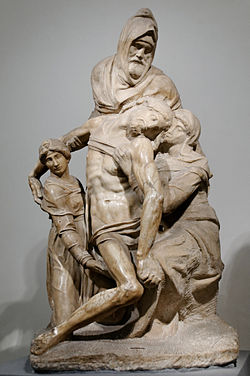The Deposition (Michelangelo)
 |
|
| Artist | Michelangelo |
|---|---|
| Year | c. 1547–1555 |
| Type | Marble |
| Dimensions | 226 cm (89 in) |
| Location | Museo dell'Opera del Duomo, Florence |
The Deposition (also called the Florence Pietà, the Bandini Pietà or The Lamentation over the Dead Christ) is a marble sculpture by the Italian High Renaissance master Michelangelo. The sculpture, on which Michelangelo worked between 1547 and 1555, depicts four figures: the dead body of Jesus Christ, newly taken down from the Cross, Nicodemus (or possibly Joseph of Arimathea), Mary Magdalene and the Virgin Mary. The sculpture is housed in the Museo dell'Opera del Duomo in Florence.
According to Vasari, Michelangelo made the Florence Pietà to decorate his tomb in Santa Maria Maggiore in Rome.
Vasari noted that Michelangelo began to work on the sculpture around the age of 72. Without commission, Michelangelo worked tirelessly into the night with just a single candle to illuminate his work. Vasari wrote that he began to work on this piece to amuse his mind and to keep his body healthy. After 8 years of working on the piece, Michelangelo would go on and attempt to destroy the work in a fit of frustration. This marked the end of Michelangelo's work on the piece and from there the piece found itself in the hands of Francesco Bandini, who hired an apprentice sculptor, by the name of Tiberius Calcagni,.to restore the work to its current composition. Since its inception, the piece has been plagued by ambiguities and never ending interpretations, with no straightforward answers available.
The face of Nicodemus under the hood is considered to be a self-portrait of Michelangelo himself.
The composition of this work has caused controversy and debate since its creation. Art historians have argued back and forth about what scene or scenes are being presented in this piece as well as the true identity of the hooded figure encapsulating the scene. Though it is regarded as a Pietà out of tradition, there is substantial evidence that suggest that this piece could either be a deposition, a Pietà, an entombment, or perhaps a scene that depicts all three. The only way to truly know which scenes or scenes are being depicted lies within the identity of the hooded figure.
...
Wikipedia
